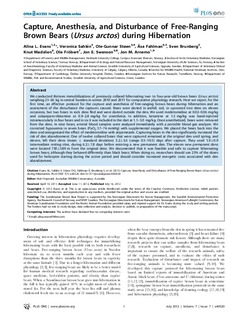Capture, Anesthesia, and Disturbance of Free-Ranging Brown Bears (Ursus arctos) during Hibernation
Evans, Alina L.; Sahlén, Veronica; Støen, Ole-Gunnar; Fahlman, Åsa; Brunberg, Sven; Madslien, Knut; Fröbert, Ole; Swenson, Jon E.; Arnemo, Jon Martin
Journal article, Peer reviewed
Permanent lenke
http://hdl.handle.net/11250/134474Utgivelsesdato
2012Metadata
Vis full innførselSamlinger
Originalversjon
Evans, A., Sahlén, V., Støen, O.-G., Fahlman, Å., Brunberg, S., Madslien, K., . . . Arnemo, J. M. (2012). Capture, Anesthesia, and Disturbance of Free-Ranging Brown Bears (Ursus arctos) during Hibernation. PLoS ONE, 7(7). doi: http://dx.doi.org10.1371/journal.pone.0040520 10.1371/journal.pone.0040520Sammendrag
We conducted thirteen immobilizations of previously collared hibernating two- to four-year-old brown bears (Ursus arctos)
weighing 21–66 kg in central Sweden in winter 2010 and 2011 for comparative physiology research. Here we report, for the
first time, an effective protocol for the capture and anesthesia of free-ranging brown bears during hibernation and an
assessment of the disturbance the captures caused. Bears were darted in anthill, soil, or uprooted tree dens on eleven
occasions, but two bears in rock dens fled and were darted outside the den. We used medetomidine at 0.02–0.06 mg/kg
and zolazepam-tiletamine at 0.9–2.8 mg/kg for anesthesia. In addition, ketamine at 1.5 mg/kg was hand-injected
intramuscularly in four bears and in six it was included in the dart at 1.1–3.0 mg/kg. Once anesthetized, bears were removed
from the dens. In nine bears, arterial blood samples were analyzed immediately with a portable blood gas analyzer. We
corrected hypoxemia in seven bears (PaO2 57–74 mmHg) with supplemental oxygen. We placed the bears back into the
dens and antagonized the effect of medetomidine with atipamezole. Capturing bears in the den significantly increased the
risk of den abandonment. One of twelve collared bears that were captured remained at the original den until spring, and
eleven, left their dens (mean 6 standard deviation) 3.263.6 (range 0.5–10.5) days after capture. They used 1.960.9
intermediate resting sites, during 6.267.8 days before entering a new permanent den. The eleven new permanent dens
were located 7306589 m from the original dens. We documented that it was feasible and safe to capture hibernating
brown bears, although they behaved differently than black bears. When doing so, researchers should use 25% of the doses
used for helicopter darting during the active period and should consider increased energetic costs associated with den
abandonment.
